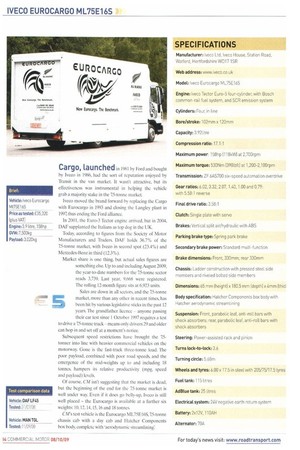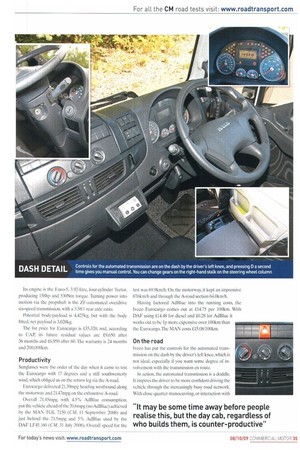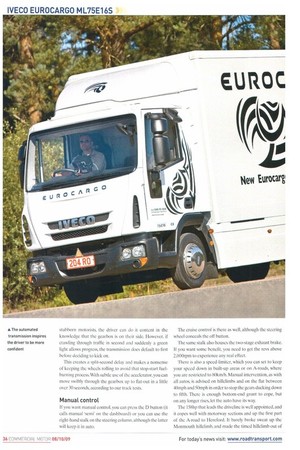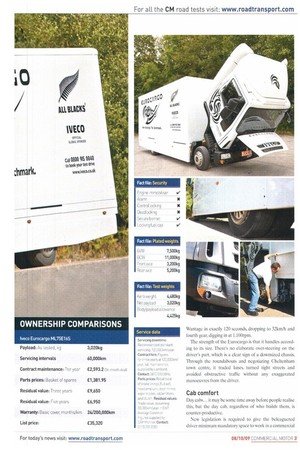Cargo, launched in 1981 by Ford and bought by Iveco
Page 34

Page 35

Page 36

Page 37

Page 38

If you've noticed an error in this article please click here to report it so we can fix it.
in 1986, had the sort of reputation enjoyed by Transit in the van market. It wasn't attractive, but its effectiveness was instrumental in helping the vehicle grab a majority stake in the 7.5-tonne market.
Iveco moved the brand forward by replacing the Cargo with Eurocargo in 1993 and closing the Langley plant in 1997, thus ending the Ford alliance.
In 2001, the Euro-3 Tector engine arrived, but in 2004, DAF supplanted the Italians as top dog in the UK.
Today. according to figures from the Society of Motor Manufacturers and Traders, DAF holds 36.7% of the 7.5-tonne market, with Iveco in second spot (23.4%) and Mercedes-Benz in third (12.3%).
Market share is one thing, but actual sales figures are something else. Up to and including August 2009, the year-to-date numbers for the 7.5-tonne sector reads 3,739. Last year, 9,668 were registered. The rolling 12-month figure sits at 6,923 units.
Sales are down in all sectors, and the 7.5-tonne market, more than any other in recent times, has been hit by various legislative sticks in the past 12 years. The grandfather licence — anyone passing their car test since 1 October 1997 requires a test to drive a 7.5-tonne truck—means only drivers 29 and older can hop in and set off at a moment's notice.
Subsequent speed restrictions have brought the 75tonner into line with heavier commercial vehicles on the motorway. Gone is the fast-track three-tonne load. The poor payload, combined with poor road speeds, and the emergence of the mid-weights up to and including 18 tonnes. hampers its relative productivity (mpg, speed and payload) levels.
Of course, CM isn't suggesting that the market is dead, but the beginning of the end for the 7.5-tonne market is well under way. Even if it does go belly-up, Iveco is still well placed — the Eurocargo is available at a further six weights: 10, 12, 14, 15, 16 and 18 tonnes.
CM's test vehicle is the Eurocargo ML75E16S, 7.5-tonne chassis cab with a day cab and Hatcher Components box body, complete with 'aerodynamic streamlining: Its engine is the Euro-5, 3.92-litre, four-cylinder Tector, producing 158hp and 530Nrn torque. Turning power into motion via the propshaft is the ZF-automated overdrive six-speed transmission, with a 3.58:1 rear axle ratio, Potential body/payload is 4A25kg, but with the body fitted, net payload is 3,020kg.
The list price for Eurocargo is £35,320, and, according to CAP, its future residual values are £9,650 after 36 months and £6,950 after 60. The warranty is 24 months and 200,000km.
Productivity
Sunglasses were the order of the day when it came to test the Eurocargo with 17 degrees and a stiff southwesterly wind, which obliged us on the return leg via the A-road.
Eurocargo delivered 21.39mpg heading westbound along the motorway and 21.47mpg on the exhaustive A-road.
Overall 21.45mpg, with 4.5% AdBlue consumption, put the vehicle ahead of the 20,6mpg (no AdB rue) achieved by the MAN TGL 7150 (CM, 11 September 2008) and just behind the 21.5mpg and 5% AdBlue used by the DAF LF45,160 (CM, 31 July 2008). Overall speed for the
test was 69.9km/h. On the motorway, it kept an impressive 876km/h and through the A-road section 64.0km/h.
Having factored AdBlue into the running costs. the Iveco Eurocargo comes out at £14.75 per 100km. With DAF using £14.48 for diesel and £0.28 for AdBlue it works out lobe lp more expensive over 100km than the Eurocargo, The MAN costs £15.08/100km.
On the road
Iveco has put the controls for the automated transmission on the dash by the driver's left knee, which is not ideal, especially if you want some degree of involvement with the transmission en route.
In action, the automated transmission is a doddle. It inspires the driver to be more confident driving the vehicle through the increasingly busy road network. With close-quarter manoeuvring, or interaction with
• The automated stubborn motorists, the driver can do it content in the transmission inspires knowledge that the gearbox is on their side. However, if the driver to be more crawling through traffic in second and suddenly a green confident light allows progress, the transmission does default to first before deciding to kick on.
This creates a split-second delay and makes a nonsense of keeping the wheels rolling to avoid that stop-start fuelburning process. With subtle use of the accelerator, you can move swiftly through the gearbox up to flat-out in a little over 30 seconds, according to our track tests.
Manual control
If you want manual control, you can press the D button (it calls manual 'semi' on the dashboard) or you can use the right-hand stalk on the steering column, although the latter will keep it in auto. The cruise control is there as well, although the steering wheel conceals the off button.
The same stalk also houses the two-stage exhaust brake. If you want some benefit, you need to get the revs above 2,000rpm to experience any real effect.
There is also a speed-limiter, which you can set to keep your speed down in built-up areas or on A-roads, where you are restricted to 80km/h. Manual intervention, as with all autos, is advised on hillelimbs and on the flat between LIOmph and 50mph in order to stop the gears ducking down to fifth. There is enough bottom-end grunt to cope, but on any longer rises, let the auto have its way.
The 158hp that leads the driveline is well appointed, and it copes well with motorway sections and up the first part of the A-road to Hereford. It barely broke sweat up the Monmouth hillelimb. and made the timed hillclimb out of Wantage in exactly 120 seconds, dropping to 32km/h and fourth gear, digging in at 1,100rpm.
The strength of the Eurocargo is that it handles according to its size. There's no elaborate over-steering on the driver's part, which is a clear sign of a downsized chassis. Through the roundabouts and negotiating Cheltenham town centre, it traded lanes, turned tight streets and avoided obstructive traffic without any exaggerated manoeuvres from the driver.
Cab comfort
Day cabs... it may be some time away before people realise this, but the day cab, regardless of who builds them, is counter-productive.
New legislation is required to give the beleaguered driver minimum mandatory space to work in a commercial vehicle — a workable square metre area to which all manufacturers must adhere.
In the existing day cab, there is simply nowhere to go. The driver requiring a 45-minute break and a power nap can't recline enough. If the driver has paperwork for multidrop work or needs to stow wet weather gear, the only answer is to lay it out across the passenger seats.
Legislators must recognise the need for space to stow any ancillary equipment, bags, coats and paperwork in a cab that doesn't have a bunk. Put stuff on the seats and one emergency braking procedure later will consign the lot to the footwell.
Blocking the pedals
Equipment, bags and the like placed in the passenger footwell or on the engine cover, always have a chance of ending up under the driver's feet and blocking the pedals, especially after any lateral movements at speed.
An extended day cab with proper storage behind the driver and a single passenger seat has to become standard. However, all things considered, Iveco has made the most of what is a confined space. There is a continuous tray across the back wall, and the back of the centre seat folds down to accommodate any extras, There are also two cupholders in the central part of the dash, and bottle holders in the doors. There is further storage above the windscreen.
The aforementioned transmission switches are a bit of a hindrance for cross-cab movement from the passenger side and the driver's side. The three switches — reverse, neutral and drive — stick out like a sore thumb.
There is no air-conditioning, windows are electrically controlled, and the mirrors need a helping hand to get them in the right position. The array of mirrors can make it time-consuming to adjust to the right position, especially if the vehicle changes drivers at every turn. •
















































































































































